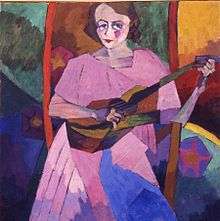Jack of Diamonds (artists)

Jack of Diamonds (Russian: «Бубновый валет», Romanized: Bubnovyi Valet), also called Knave Of Diamonds, was a group of avant-garde artists founded in 1910 in Moscow. The group remained active until December 1917.[1]
Inception
The Knave of Diamonds was an exhibition that opened in Moscow in December 1910, featuring French cubist paintings by Henri Le Fauconnier, André Lhote, Albert Gleizes and Jean Metzinger. Curated by Alexandre Mercereau,[2] the exhibition included works of four Russian artists expelled from the Moscow School of Painting, Sculpture and Architecture due to their "leftist tendencies".[3] A stated objective of the exhibition was "to offer young Russian artists who find it extremely difficult to get accepted for exhibitions under the existing indolence and cliquishness of our artistic spheres, the chance to get onto the main road."[1]
Subsequently the title was adopted by a newly formed artistic society in Moscow. Soon thereafter, this group became the largest and one of the most significant exhibition societies of the early Russian avant-garde.
The name itself was coined by Mikhail Larionov for the exhibition of 1910 because he liked the sound of it.[3] A contemporary account included, "Organizers regard the title Knave of Diamonds as a symbol of young enthusiasm and passion, 'for the knave implies youth and the suit of diamonds represents seething blood.'"[1]
Well-known painters that participated in the first Jack of Diamonds exhibition, in addition to the French Cubists were Mikhail Larionov, Natalia Goncharova, Kazimir Malevich (and later, Léopold Survage).
Membership Growth
The group included Robert Falk, Aristarkh Lentulov, Ilya Mashkov, Alexander V. Kuprin, Adolf Milman, Alexander Osmerkin, Wladimir Burliuk, Pyotr Konchalovsky and Moisey Feigin.[4] Their works demonstrate the artists’ interest in the developing of the new styles (Russian Primitivism, Russian Cezanneism, Moscow School of Neo-Primitivism, oth.) that emerged around their first exhibition as a result of their integrating folk art of the provinces in the artworks. Other new styles and genres, such as performance and body-art, emerged from this unlikely blending of fine European art, Russian folk art, and urban folk of the masses in Russia. The artistic significance of the individual members of The Knave of Diamonds aside, their activities conditioned a qualitative shift in Russian of the 1910s, among most important changes - democratization of the art society in Russia.
Exhibitions
- Knave of Diamonds, Moscow, 10 December 1910 – 16 January 1911, Levinson house, Bolshaya Dmitrovka Street, Moscow
- Knave of Diamonds, 23 (or 25) January – 26 February 1912, Moscow Military District Economic Society of Officers, 10 Vozdvizhenko, Moscow
- Knave of Diamonds, 7 February – 7 March 1913, Levinson house, Bolshaya Dmitrovka Street, Moscow, 3 – 28 April, St. Petersburg
- Knave of Diamonds, 5 February – 2 March 1914, Society of Lovers of Art, Moscow
- Artists of Moscow for Victims of the War, 6 December 1915 – 18 January 1916
- Knave of Diamonds, 6 November – 19 December 1916, Kira Mikhailova Art Salon, Bolshaya Dmitrovka Street, Moscow
- Knave of Diamonds, 21 November to 3 December 1917, Kira Mikhailova Art Salon, Bolshaya Dmitrovka Street, Moscow
Influences
The Jack of Diamonds defined "the Russian pre-revolutionary culture", a favorite culture of the Moscow intelligentsia in the 1970s.[5]
Related Artist Groups
Later Mikhail Larionov and his followers disagreed with the group's ethos and formed the more radical Donkey's Tail.
Further reading
- G. G. Pospelov, Bubnovii Valet / Knave of Diamonds, Moscow, 1990.
- State Russian Museum, State Tretiakov Gallery, Ekaterina Cultural Foundation, The Knave of Diamonds in the Russian Avant-Garde. St. Petersburg: Palace Editions, 2004.
- Benedikt Livshits, The One and a Half-Eyed Archer (1931). Translated by John E. Bowlt. Newtonville, Mass: Oriental Research Partners, 1977, pages 69–96.
References
- 1 2 3 Railing, Patricia. "Knave of Diamons: Brief History". International Chamber of Russian Modernism (InCoRM). Retrieved 28 October 2012.
- ↑ Louis Vauxcelles, Gil Bias, March 18, 1910. Quoted in John Golding, Cubism, London, 1959, p. 22. See Toison d'Or, Moscow, 1908, nos. 7-10, p. 15
- 1 2 Hamilton, George H (1967). Painting and Sculpture in Europe, 1880-1940: 4th Edition. Penguin Books. pp. 307–310. ISBN 0300056494.
- ↑ "World Oldest Artist Aged 104 Dies". Russia Info Centre. Retrieved 28 October 2012.
- ↑ Varoli, John (29 November 2005). "Alfa Bank's Aven Rivals Museums With His Collection (Update1)". Bloomberg. Retrieved 28 October 2012.
External links
- Knave of Diamonds, InCoRM (International Chamber of Russian Modernism), Compiled by Patricia Railing